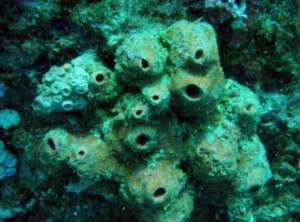Sponges that sponge off bacteria

Medical compounds harvested from a marine sponge are actually produced by symbiotic bacteria living in the sponges.
A research team used single-cell genome analysis, and metagenomic sequencing to find that just two bacterial tenants of a marine sponge, Theonella swinhoei, make medically important compounds called polyketides. Both bacteria belong an uncultivated genus, Enthotheonella. The research team suggests that these bacteria belong in a new phylum, which they dubbed "Tectomicrobia."
The use of single-cell genomics and metagenomics allowed the team to bypass the traditional culturing step and identify these previously uncultured bacteria. It highlights the potential of both techniques and provides new enticements to apply to environmental samples for drug discovery as well as for sourcing enzymes for such industrial applications as biofuels. T. swinhoei is a widely distributed sponge and can alter the water chemistry of their environment by rapidly pumping water through their tissues where nutrients are absorbed and waste products released. So this finding also has implications for studying global carbon and nitrogen cycles.
The kidney-red coral reef sponge, T. swinhoei, lives throughout the tropical regions of the Indian and Pacific Oceans and is a source of several anti-fungal and anti-cancer drug candidates. These compounds aren't produced by the sponge itself, but by symbiotic bacteria that live inside it. Researchers from the Institute of Microbiology at ETH Zurich, Switzerland, working with the U.S. Department of Energy Joint Genome Institute and several other academic institutions used advanced sequencing methods to zero in on the bacteria, which belong to an uncultivated genus, Enthotheonella. Their findings were published February 6, 2014 in the journal Nature.
Scientists have been harvesting medically important compounds from bacteria grown in labs for decades, but it's estimated that these "cultivated bacteria" represent only one percent of known microbes on the planet, and it's unclear how many of the uncultivated 99 percent are capable of producing other useful natural compounds. This is the first time researchers have pinpointed an uncultivated bacterium as a prolific source of bioactive compounds.
The team used single-cell genome analysis, examining the genomes of individual cells, and metagenomic sequencing, analyzing the DNA of an environmental sample, to find the bacteria responsible, bypassing the traditional culturing step. In this particular study, JGI provided a phylogenetic analysis, which deciphers the evolutionary history of bacterial lineages
For the paper, researchers studied T. swinhoei from Japan, but also found closely related Enthotheonella living inside of other T. swinhoei sponges. They suggested this group of bacteria belongs in a new phylum, which they have named "Tectomicrobia," which derives from the Latin word, tegere, (to hide, to protect), which reflects their uncultured "hidden" nature and highlights that the compounds they produce are likely used for chemical defense.
More information: Wilson et al. An environmental bacterial taxon with a large and distinct metabolic repertoire. Nature. 2014 Feb 6;506(7486):58-62. DOI: 10.1038/nature12959. DOI: 10.1038/nature12959
Journal information: Nature
Provided by DOE/Joint Genome Institute



















